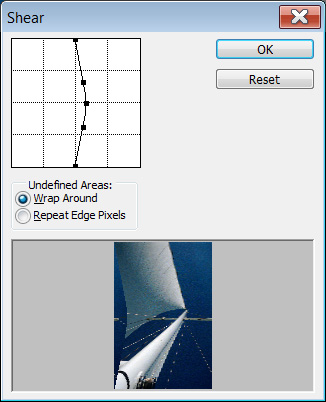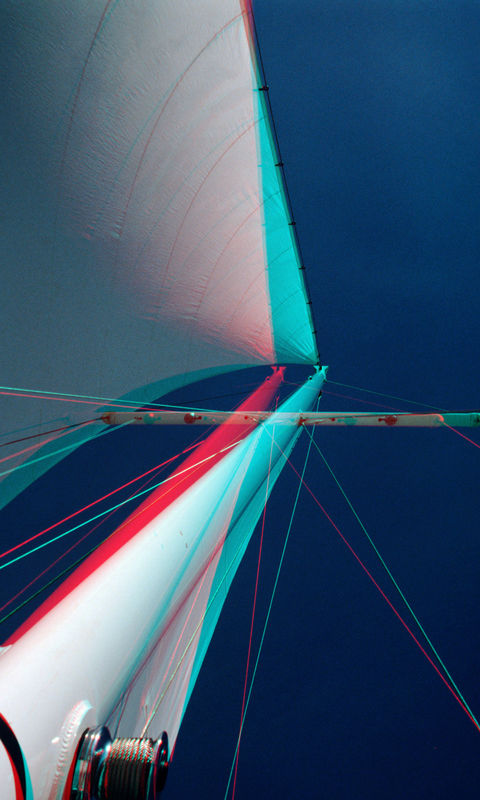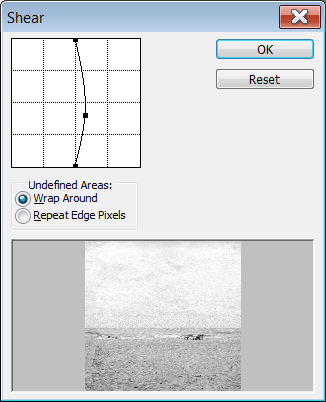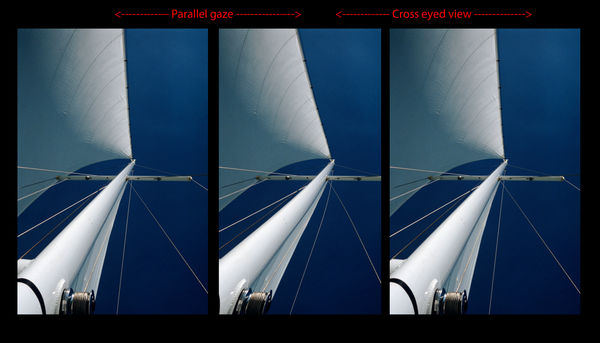2D-3D Conversion - It's not that simple
Dec 31, 2018 11:34:03 #
You will need to use anaglyph glasses to view the 3D effect.
The original image was loaded into PS Elements. To create the right eye view, I used the Shear tool (Filter/Distort/Shear...). The tool is quite small so you need to be very careful. After creating a distorted right eye view, I loaded the original (left) and distorted (right) image into StereoPhoto Maker to create the anaglyph combination.
1. The image needs to be simple. The technique will not work with shapes any more complex than the one shown in this example. In this case, there is a single clear vanishing point and no overlapping elements.
2. The displacement must be only horizontal (our eyes are side-by-side) and to the right (if you distort to the left you will need to switch the order of the images later). Any vertical displacement of the image is going to make the 3D effect difficult to see.
3. If an image contains straight lines, care must be taken to insure that the distortion is linear and in proportion to the distance from the camera. That's not easy with the small Shear dialog.
4. Trying to address more than a single vanishing point is practically impossible.
Any deviation from these restrictions and you are probably going to end up with a mess.
Of course, a much simpler approach is to take two images in the first place.
The original image was loaded into PS Elements. To create the right eye view, I used the Shear tool (Filter/Distort/Shear...). The tool is quite small so you need to be very careful. After creating a distorted right eye view, I loaded the original (left) and distorted (right) image into StereoPhoto Maker to create the anaglyph combination.
1. The image needs to be simple. The technique will not work with shapes any more complex than the one shown in this example. In this case, there is a single clear vanishing point and no overlapping elements.
2. The displacement must be only horizontal (our eyes are side-by-side) and to the right (if you distort to the left you will need to switch the order of the images later). Any vertical displacement of the image is going to make the 3D effect difficult to see.
3. If an image contains straight lines, care must be taken to insure that the distortion is linear and in proportion to the distance from the camera. That's not easy with the small Shear dialog.
4. Trying to address more than a single vanishing point is practically impossible.
Any deviation from these restrictions and you are probably going to end up with a mess.
Of course, a much simpler approach is to take two images in the first place.
Dec 31, 2018 11:38:30 #
A little ghosting but otherwise tremendous depth. I've never heard of the shear technique before. Very interesting. Thanks for posting.
BTW, now I see what your avatar is all about.
BTW, now I see what your avatar is all about.
Dec 31, 2018 11:43:26 #
Fotoartist wrote:
A little ghosting but otherwise tremendous depth. I've never heard of the shear technique before. Very interesting. Thanks for posting.
I had to search a bit to find it. It's pretty cumbersome to use. Maybe some other editor has a simpler tool.
When I really want a 3D image I just take two shots side-by-side. It takes care of everything.
Dec 31, 2018 11:44:42 #
Yeh, but what if you want to make an old master painting 3D?
selmslie wrote:
I had to search a bit to find it. It's pretty cumbersome to use. Maybe some other editor has a simpler tool.
When I really want a 3D image I just take two shots side-by-side. It takes care of everything.
When I really want a 3D image I just take two shots side-by-side. It takes care of everything.
Dec 31, 2018 11:53:48 #
Fotoartist wrote:
Yeh, but what if you want to make an old master painting 3D?
Then you are probably out of luck.
Even with a simple landscape you can easily screw things up if you don't know the limitations - especially #2 above.
Jan 1, 2019 09:25:04 #
selmslie wrote:
Then you are probably out of luck.
Even with a simple landscape you can easily screw things up if you don't know the limitations - especially #2 above.
Even with a simple landscape you can easily screw things up if you don't know the limitations - especially #2 above.
Here is another example.
The subject is as simple as it gets - not even any long straight non-horizontal lines. Everything from the beach to the horizon is pretty much in the same plane.
Zooming in (the image is a 66MP medium format scan) does not affect the 3D effect but you may need to step back from your screen to see it.
Jan 2, 2019 10:40:02 #
Fotoartist wrote:
A little ghosting but otherwise tremendous depth. I've never heard of the shear technique before. Very interesting. Thanks for posting.
.
.
Fotoartist,
“Shear” is “graphic art speak” used by some graphic/design artists for any free transformation used to suggest
an emphasis of, or change in perspective.
Free Transformation is available in PS, as well as in a number of free or low-cost photo processing apps.
For those who cannot bilaterally and accurately coordinate the convergence-accomodation (C-A) ocular neuro-muscular reflex that permits foveation of comparable disparate detail points displaced throughout 360° (vertical, all diagonals, and horizontal) but are not fully stereo blind, such few so-afflicted may be able to use anaglyphs for their 3D experience. However, because use of anaglyph glasses requires almost exclusively horizontally displaced disparities, anaglyphs do need to be based on ortho stereographic image pairs or other image pairs with predominantly horizontal parallax.
The approximately 86% of the population that enjoy fully coordinated, 360° foveation also enjoy ease of free viewing stereo image pairs of all sorts without the need to resort to the additional steps of processing and the requisite use of special, two-color viewing glasses necessary to accomplish the “anaglyph” approach to 3D imagery. Obviously, anagraph imagery can also be used by those fully capable of 360° foveation but who simply are not inclined to learn use of traditional “free viewing” of 3D image pairs.
Note that it is simply ludicrous to claim that 3D image pairs with other than exclusively horizontal disparity offsets cannot fully support stereopsis with traditional viewing methods by the major part of the population).
A useful article on anaglyph imagery (that also points out its distinct short-comings regarding “ghosting”, decreased resolution, and color rendition) is:
Woods, Andrew J. and Tegan Woods, “Ghosting in Anaglyphic Stereoscopic Images”,
Proceedings of the SPIE, Volume 5291, p. 354-365 (2004)
http://cmst.curtin.edu.au/wp-content/uploads/sites/4/2016/05/2004-08.pdf
Best regards,
Dave
Jan 2, 2019 14:55:21 #
Uuglypher wrote:
Fotoartist,
“Shear” is “graphic art speak” used by some graphic/design artists for any free transformation used to suggest
an emphasis of, or change in perspective. ...
Note that it is simply ludicrous to claim that 3D image pairs with other than exclusively horizontal disparity offsets cannot fully support stereopsis with traditional viewing methods by the major part of the population). ....
“Shear” is “graphic art speak” used by some graphic/design artists for any free transformation used to suggest
an emphasis of, or change in perspective. ...
Note that it is simply ludicrous to claim that 3D image pairs with other than exclusively horizontal disparity offsets cannot fully support stereopsis with traditional viewing methods by the major part of the population). ....
You can't, of course, change the perspective (viewpoint) of an image by any form of distortion whether you use Shear or any other method. You can, as I showed in my first post, fake it so that it will appear to work with a simple scenario so long as you conform to the listed constraints.
All definitions of Binocular vision come down to the unarguable fact that our eyes, being side-by-side, give us the ability to perceive a sensation of 3D because they receive information from two slightly separate viewpoints. As the article states, "The overlapping of vision occurs due to the position of the eyes on the head (eyes are located on the front of the head, not on the sides). This overlap allows each eye to view objects with a slightly different viewpoint. As a result of this overlap of vision, binocular vision provides depth."
Can we see 3D in a properly prepared pair of images by free viewing?
Most of us can do this but there are a couple of practical constraints:
1. Our eyes are about 2.5" (6.4 cm) apart. For parallel viewing, the center of the two images cannot be more than 2.5" apart because most of us cannot direct our eyes beyond a parallel gaze. That means that each image is limited to 2.5" in width.
2. For cross-eyed viewing, there is a limit to how closely we can view two images and cross our eyes to make them overlap. It becomes difficult to cross our eyes more than a normal reading distance of about 15 inches. The ratio of 15:2.5 is 6 so we can actually work with images larger than 2.5 inches in width if we back away from the display proportionately. For example, you might comfortably view a pair of 5 inch wide images from a distance of 30 inches with crossed eyes.
In either case, it takes some effort and possibly even some discomfort. It is difficult to sustain such a gaze for any length of time. It is even more difficult to examine the entire surface of the image while keeping our eyes locked in position.
Can we see 3D in a properly prepared pair of images via anaglyph or other presentation?
All we need is the anaglyph glasses or some other visual aid to isolate the two images. There is no size restriction on the image (unless they are being viewed in a stereo viewer like a ViewMaster). We can then examine the entire surface of the image, corner to corner, with no discomfort.
But all of this assumes that the image pairs are properly prepared - that they can actually be recognized as providing a 3D impression by either method. If you think that you can see 3D with free viewing but it fails when converted to anaglyph then it has not been properly prepared.
You yourself have admitted that 2D-3D conversion has its limits when it comes to distorting an image trying to do a conversion, "I have spent far more time than I care to admit trying to carry out 3D conversion..." If you really understood the issues you would not have even attempted it.
Jan 2, 2019 15:00:40 #
Here is one of the PMs I sent you that you have been afraid to read:
Don't shoot the messenger! Remember, you contacted me.
Don't blame me if your method doesn't work. Mine does. Here's proof that I understand the topic better than you do.

You could never have pulled this off from a single image using your approach.
I have posted many examples of how to do it and learned some things along the way. You have never revealed how you distort the image.
If you would rather converse with someone who doesn't know what you are talking about and thinks you are a magician, knock yourself out.
Scotty
Uuglypher wrote:
It is senseless to continue to attempt a dialogue on stereopsis, 3D imagery,and binocular and monocular cues to depth perception with one whose knowledge of these areas is almost four decades out-of-date and who is totally ignorant of the remarkable advances made in the functional anatomy, micro anatomy, and neurophysiology of the human visual apparatus during the past four decades. Of none of those areas of research findings have you demostrated the slightest awareness or interest. ...
Don't shoot the messenger! Remember, you contacted me.
Don't blame me if your method doesn't work. Mine does. Here's proof that I understand the topic better than you do.

You could never have pulled this off from a single image using your approach.
I have posted many examples of how to do it and learned some things along the way. You have never revealed how you distort the image.
If you would rather converse with someone who doesn't know what you are talking about and thinks you are a magician, knock yourself out.
Scotty
Jan 2, 2019 15:01:21 #
And here is the other one:
As a clear example of your lack of understanding, see your post https://www.uglyhedgehog.com/t-499016-3.html#8822510 in which you admit to having spent, "far more time than I care to admit trying to carry out 3D conversion of this magnificent image." You may have spent five months on it off and on.
The fact that you could not tell at a glance that your method would fail there is proof that you are in over your head - you don't understand the principle.
It could have been accomplished with ease with two images captured side-by-side. Here is an image with lots of parallel and diagonal lines:

A trivial exercise for me, impossible for you.
Scotty
Uuglypher wrote:
It is senseless to continue to attempt ....
As a clear example of your lack of understanding, see your post https://www.uglyhedgehog.com/t-499016-3.html#8822510 in which you admit to having spent, "far more time than I care to admit trying to carry out 3D conversion of this magnificent image." You may have spent five months on it off and on.
The fact that you could not tell at a glance that your method would fail there is proof that you are in over your head - you don't understand the principle.
It could have been accomplished with ease with two images captured side-by-side. Here is an image with lots of parallel and diagonal lines:

A trivial exercise for me, impossible for you.
Scotty
Jan 2, 2019 15:29:38 #
You can Google for more information on creating stereo photographs. For example, How to Create Stereo Photographs.
In nearly all cases you will find that you need to capture two images from two horizontally separated viewpoints.
Some methods can be quite complicated and difficult but the easiest way to do it is to take a hand-held image, move to the right and take a second image. Of course, this only works for stationary subjects.
In nearly all cases you will find that you need to capture two images from two horizontally separated viewpoints.
Some methods can be quite complicated and difficult but the easiest way to do it is to take a hand-held image, move to the right and take a second image. Of course, this only works for stationary subjects.
Jan 3, 2019 08:18:45 #
selmslie wrote:
And here is the other one: br br As a clear examp... (show quote)
That you cannot see the difference between a simple, linear perspective image with a predominant, central vanishing point (your image) and Linda’s image with incredibly complex, multiple perspectives with almost countless vanishing points, some within the image and some beyond the margins of the image...indicates that your discernment of degrees of linear perspective and the principles of monocular depth cue stereography is even less, by far, than I had suspected.
Give it up, sad lad.
As I have urged you to do, catch up on the past four decades of research and literature on depth perception, functional visual neuroanatomy and neurophysiology, paying particular attention to concepts relating to retinal image disparities, binocular foveation, and coordination of the bilateral vergence (convergence)-accomodation neuromuscular reflex...
and then rejoin the conversation with a useful level of factual grounding. Until then, your contribution is sadly out-dated, pseudo authoritative babble.
Now you should understand the difference between revealing your ignorance to me by personal messages and to the world by public revelation of those self-indicting personal messages. It was your choice!
Signing out.
Jan 3, 2019 09:30:00 #
Uuglypher wrote:
... You just don't understand the subject. Too bad. It's just a matter of geometry.
And you often cannot see the 3D in your own image - Image of another artist's handiwork (sculpture)
You never responded to magnetoman's comment that, "Still can't get the stereos working Dave."
Why not? Because it wasn't there. If you overlap the two images, both images are identical.
You made the same mistake four more times because you could not view your own 3D using parallel or cross eyed view. I discovered it easily when I looked at the anaglyph version.
Jan 3, 2019 10:01:46 #
Uuglypher wrote:
That you cannot see the difference between a simple, linear perspective image with a predominant, central vanishing point (your image) and Linda’s image with incredibly complex, multiple perspectives with almost countless vanishing points, some within the image and some beyond the margins of the image...indicates that your discernment of degrees of linear perspective and the principles of monocular depth cue stereography is even less, by far, than I had suspected. ...
The fact that you could not instantly recognize that Linda's image would be impossible to convert to 3D says everything about your understanding of 3D. If you are basing your efforts on vanishing points you are barking up the wrong tree.
I have posted several images with multiple pairs of overlapping parallel lines with different vanishing points like this one:

and this one to illustrate the problem of subject movement:

and this one:

and this one:

You can clearly see the 3D in each of these images. They were all easily created from two captures. Each one would have been impossible to construct using distortion due to the number of overlapping elements. The 3D effect is independent of any clues you might deduce from vanishing points, if any can be identified.
I realize that you are reluctant to abandon three years worth of fruitless efforts but you have rarely come close to a reasonable 2D-3D conversion that works. Even when you came close, you did not understand why.
You just don't understand the subject. Too bad. It's just a matter of geometry.
Jan 3, 2019 11:44:51 #
I sure don't want to get into a verbal war with either of you guys.
If you want to reply, then register here. Registration is free and your account is created instantly, so you can post right away.







